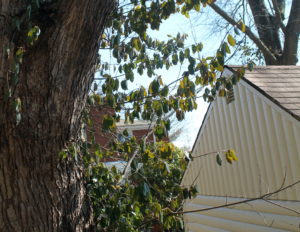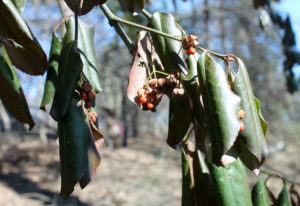The Power of a Weed Seed
April 16th, 2019
I was not aware that, left to its own devices for a dozen or so years, winter creeper plants can grow into trees with trunks the size of my ankle.
It’s a plant that matures seeds with a vengeance, banking up future baby winter creepers for years to come.
In other words, winter creeper can become a very big and very troublesome invader in a short time.
I mention this because my new “landscape” in Pittsburgh is overrun with creeping winter creeper, climbing winter creeper, and stand-alone winter creeper trees. The best I can figure with the latter is that winter creeper climbed up a supporting plant (probably rose of sharon, another problem weed in my Pittsburgh yard), then killed the host plant after it trained as an upright.
It’s obvious no one has checked the growth and spread of these plants in a long time.
I’m now paying the price for years of neglect. Worse yet, even after I get the climbers out of the junipers and maples and dig out the many stand-alone winter creeper trees, I’m going to face an ongoing battle of new winter creeper seedlings.
To me, stored and lurking weed seeds pose a bigger threat than existing weeds. Get rid of a weed, and if it has had a chance to drop seed over the years, all the removal does is open space for sunlight and moisture to germinate a whole new outbreak.
Disturb the soil even years later, and that brings dormant weed seeds to the surface, where they sprout after years of waiting for the warmer, brighter opportunity.
So, I’m gearing up for a battle I’d rather not have to fight at my age (not that fighting weeds is fun or easy at any age).
The first step is getting rid of the existing winter creeper, especially the big, damaging plants and the ones that have gone to seed.
Climbing winter creeper can kill trees, not by rooting into the trunks, but by its leaves that grow out to cover the tree’s foliage.
Winter creeper foliage blocks sunlight from reaching the tree foliage, causing a slow death from lack of the light needed for photosynthesis.

Winter creeper has grown up this maple tree, and its leaves are starting to block sun from reaching the tree’s leaves.
Getting rid of seeds before they mature is also critical. That shuts down the ongoing “seed bank” situation in which future winter creeper seedlings keep gathering forces in the soil.
I really don’t want any more seeds than what’s been deposited there for years.
I’m going to try and put a lid on sprouting by mulching all around new plantings. That should shut off some light and counteract the igniting of sprouting that’s going to happen when I disturb the soil by pulling and planting and then watering my new plants.
Then I’ll closely and regularly monitor the “battlefield” to pull any seedlings as soon as I see them.
Some people would also employ Roundup and weed-preventing chemicals, but I’d rather not get into the expense and possible off-target effects of those.
I’m pretty much a dig, pull, mulch, and monitor kind of weed-fighter.
That approach worked really well for me at my Mechanicsburg house over the last 30 years.
There, I stayed on top of the weeds, yanking unwanted babies almost as soon as they popped up.
The key was regular patrolling. I’d “inspect the troops” every few weeks with a five-gallon bucket and a weeding tool.
Those young weeds came out easily and never had a chance to think about going to seed. In other words, I closed their bank account. No deposits allowed.
I looked at the patrols as “harvesting compost” because I’d dump the young weeds in my compost pile to help create the immaculate soil I eventually developed. The enemy became an ally.
The result was that weeds were not an issue in that yard at all. They actually dwindled in number over the years.
That’s the benefit of staying on top of things. Look at it this way… you can either do a little work regularly, or you can ignore things and face an overwhelming jungle that’s going to be way more back-breaking in the long run.
Or I guess you can do what the previous owners of my Pittsburgh house did – let the next owner worry about it.








